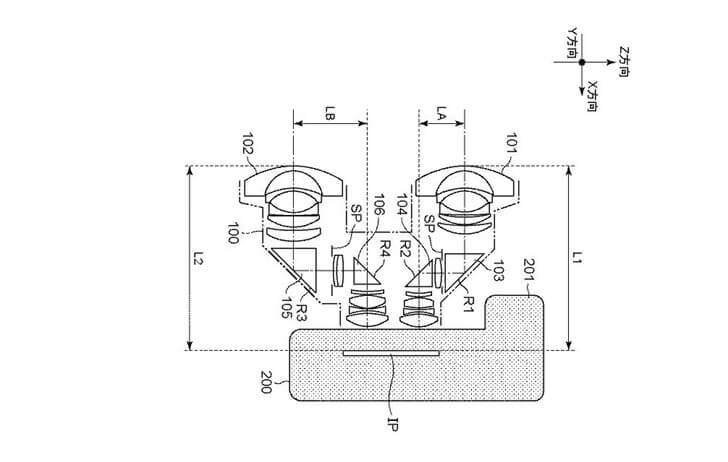Canon News has uncovered an interesting patent for a stereoscopic lens for what appears to be the RF mount.
According to the patent, this would only work on a full-frame camera, as the two lenses have an image height of 8.75mm which fits perfectly for a full-frame sensor.
According to the patent language, the application is for a camera, as the design takes into account a camera grip for usability.
In the lens device, since the angle of view of the optical system is relatively narrow and the distance (baseline length) between the optical axes of the two optical systems is short, the realism of the obtained stereoscopic image is not sufficient. On the other hand, in the imaging apparatus described in Patent Document 1, when the two optical systems to try to increase the base length with a wide-angle of view, lens apparatus is enlarged. In this case, when the lens device is attached to the main body of the imaging device, the grip performance (easiness to hold) may be affected. It is an object of the present invention to provide a lens device that enables stereoscopic photography and does not impair ease of holding.
What's the application for such a lens? I'm not too sure at the moment. Maybe some of you will know.
Canon stereoscopic lens specifications (this is for both lenses):
- Focal length:5.57mm
- F-number: 2.80
- Half angle of view: 90.00°
- Image height: 8.75mm
- Total lens length: 96.00mm
- BF: 13.50mm


Stereo photos used to be used for Viewmaster stereoscope reels, now, they are used to get 3D effects for Virtual Reality. I suppose that would be the most likely application.
As I understand this this would be two anamorphic lenses in one with the added difficulty that the left one has to be offset further out to provide proper eye distance while still leaving enough space for the Hand around the grip if you were to use it with an R6/ R5. So the focal length of the left lens would have to be slightly shorter and faster to make up for the longer distance.
Interesting.
Yes, it certainly looks like a stereoscopic fisheye lens. We've been doing a lot of work with stereoscopic imagery for my website, and would certainly find a use for this (although a stereoscopic macro lens would be even better)
But measuring objects might be a good application for a high res stereo image with one camera. E.g. for checks on large buildings if everything is in place ...
By the way: To do that calculation seems hard work - two lenses with different distances to the sensor but very very similiar image properties to give a good stereo view ...
Geez! Why don't you just buy 2 R5s and 2 lenses and build a bracket to hold them together? :ROFLMAO:
Because it would double cost & weight, and probably harder to calibrate.
I've always loved the View-Master slides & viewer, and wished there was a great mainstream stereo camera I could use, and envisioned it as a double lens & mount on the far left & right of a single body, and a separate viewer of some sort to view the result later. But maybe you could have both in a single body by putting the lenses at the top left & right and having 2 viewfinders with adjustable eye spacing and a cutout in the bottom center for your nose. That basically becomes a binocular camera, which I would dearly love to have!
It seems odd to try to pack 2 lenses into one lens body that funnels the light from 2 views which must be kept separate onto a single sensor, which I assume is done by making their images so small that they fit separately on the left & right sides of the sensor, with lots of wasted sensor space around both of them.
I guess the reason that this patent was done is that it is economically possible to have a single lens made (no matter how great the complexity and loss of IQ) to fit on a currently produced mainstream camera.
You know, Canon does make stellar image stabilized binoculars. Why don't they just put 2 sensor&EVFs on them and come out with a line of binocular cameras, with some having a wide angle of view or possibly with zoom ability. That's what I'd buy! :D
Or if the cameras were as close together as possible on a nice tripod then you could get stills or video with moving subjects just like you would with a regular camera on a tripod.